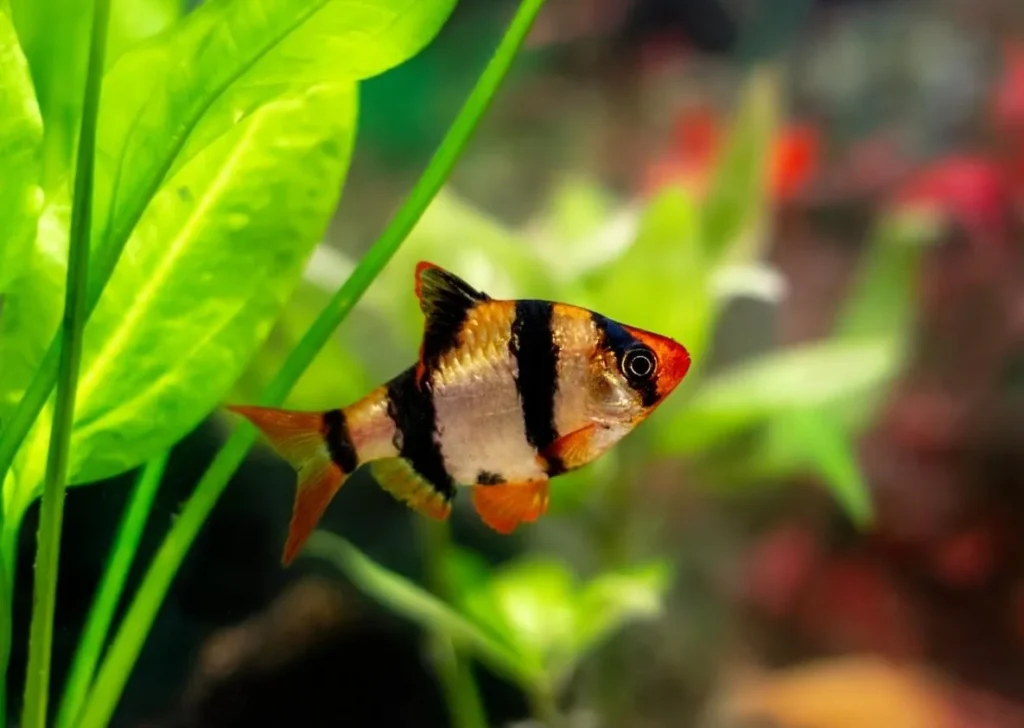Discover everything you need to know about Tiger Barb care! Learn about their tank setup, lifespan, size, diet, and best tank mates. Perfect for aquarists who want to keep these energetic and colorful fish thriving.
Few freshwater fish light up an aquarium like Tiger Barbs. With their bold stripes, nonstop energy, and playful nature, they’re often the life of the tank. But don’t let their beauty fool you—Tiger Barbs need the right care and environment to thrive.
When I first kept a group of Tiger Barbs, I was amazed by how much personality these little guys brought to the aquarium. They were like the “class clowns” of the tank—always chasing, always exploring, and always keeping me entertained.
👉 Quick Answer: Tiger Barb care means keeping them in groups of 6+, providing a 20–30 gallon tank, offering a varied diet of flakes, pellets, and live foods, and choosing tank mates wisely to avoid aggression.
Tiger Barb Overview
Before diving into the details of Tiger Barb care, here are the basics:
-
Scientific Name: Puntigrus tetrazona
-
Origin: Southeast Asia (Borneo, Sumatra)
-
Temperament: Semi-aggressive, especially in small groups
-
Care Level: Moderate
These fish are popular among beginners and experienced aquarists alike because they’re hardy, colorful, and full of personality. But to keep them happy, you need to understand their needs.
Tiger Barb Size & Max Size
👉 Short Answer: Tiger Barbs grow to about 2.5–3 inches, with a max size of around 3.5 inches in captivity.
They’re small enough to fit comfortably in community tanks but big enough to be noticed. My oldest female Tiger Barb hit 3 inches and was easily the boss of the group.
💡 Tip: Their size makes them perfect for mid-sized tanks, but remember—they need a group, so the tank still needs space.
Tiger Barb Lifespan
👉 Short Answer: Tiger Barbs live 5–7 years with proper care, though some have reached 8 years in excellent conditions.
Their lifespan depends heavily on water quality and diet. Poor water conditions shorten their lives dramatically. I lost my first group within 2 years because I underestimated how sensitive they are to unstable water. Lesson learned—keep the water clean, and they’ll stick around.
Tiger Barb Tank Setup
Tank setup can make or break your success with Tiger Barbs.
👉 Short Answer: Tiger Barbs need at least a 20-gallon tank, live plants, swimming space, and strong filtration.
Here’s what works best:
-
Tank Size: 20 gallons minimum for a small group, 30+ gallons preferred.
-
Substrate: Sand or smooth gravel.
-
Decorations: Live plants, driftwood, and rocks for cover.
-
Swimming Space: Leave open areas for active swimming.
-
Filtration: Strong filter to handle their waste and activity.
Tiger Barb Diet
Feeding Tiger Barbs is one of the most enjoyable parts of owning them—they’re greedy, fast, and love variety.
👉 Short Answer: Tiger Barbs need a balanced diet of flakes, pellets, frozen, and live foods.
Here’s a good mix:
-
Staple: TetraMin Tropical Flakes – reliable and nutrient-rich.
-
Pellets: Hikari Micro Pellets – perfect for smaller mouths.
-
Frozen/Live Foods: Bloodworms, brine shrimp, daphnia.
-
Veggies: Blanched spinach or peas once in a while.
My group goes wild for frozen brine shrimp. Feeding time looks like a tiny feeding frenzy, and it’s honestly one of my favorite moments as a fish keeper.
Tiger Barb Tank Mates
This is where things get tricky—Tiger Barbs are notorious fin-nippers.
👉 Short Answer: Best tank mates are fast, active fish that can hold their own. Avoid slow, long-finned species.
Good tank mates include:
-
Other Tiger Barbs (always keep them in groups of 6 or more)
-
Danios
-
Cherry Barbs
-
Loaches
-
Plecos
Avoid: Angelfish, Bettas, Guppies, or any long-finned fish.
💡 From experience: I once tried keeping Tiger Barbs with Angelfish. Big mistake. The Barbs wouldn’t leave the Angels alone until I separated them.
Behavior & Personality
👉 Short Answer: Tiger Barbs are energetic, playful, and sometimes aggressive.
They love to chase each other around the tank, establishing pecking orders. This is normal and part of their charm. But if they’re kept in too small a group (fewer than 6), that aggression gets directed toward tank mates instead.
Watching them interact is like watching a group of siblings—sometimes playful, sometimes bossy, but always entertaining.
Breeding Tiger Barbs
Breeding Tiger Barbs is possible in home aquariums with the right setup.
👉 Short Answer: They scatter eggs in planted tanks, and parents don’t provide care.
Tips for success:
-
Set up a separate breeding tank.
-
Add fine-leaved plants or spawning mops.
-
Condition them with live foods.
-
Remove adults after spawning to prevent egg eating.
I bred them once accidentally when my heavily planted tank gave them the perfect environment. I only saved a few fry, though, because the adults had a buffet before I could intervene.
Common Health Issues
👉 Short Answer: Tiger Barbs are hardy but can suffer from Ich, fin rot, and stress-related issues.
Prevention tips:
-
Quarantine new fish.
-
Perform weekly water changes.
-
Avoid overcrowding.
-
Keep a balanced diet.
Tips for Success with Tiger Barb Care
-
Keep Groups of 6+: Reduces aggression.
-
Choose Tank Mates Carefully: Fast fish only.
-
Feed Variety: Flakes, pellets, and live food.
-
Keep the Water Clean: Weekly water changes are a must.
-
Watch Their Behavior: They’ll tell you if they’re stressed or unhappy.
Final Thoughts on Tiger Barb Care
Tiger Barbs aren’t just beautiful—they’re fun, engaging, and full of personality.
👉 Quick Recap:
-
Size: 2.5–3 inches.
-
Lifespan: 5–7 years.
-
Tank Setup: 20–30 gallons with plants and swimming space.
-
Diet: Flakes, pellets, live/frozen foods.
-
Tank Mates: Fast-moving fish, avoid long-finned species.
If you’re ready for their playful energy (and occasional mischief), Tiger Barbs will quickly become the stars of your aquarium.

